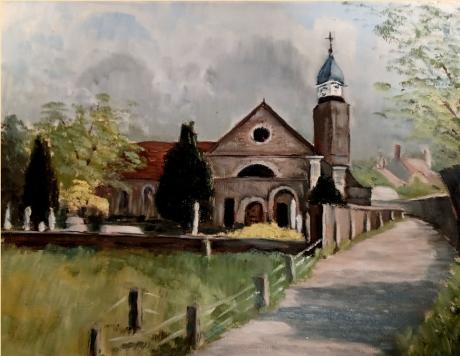" P Yates" and inscribed on the reverse with title
St Peter's Church is the parish church of the village of Petersham in the London Borough of Richmond upon Thames. It is part of the Diocese of Southwark in the Church of England. The main body of the church building dates from the 16th century, although parts of the chancel are 13th century and evidence in Domesday Book suggests that there may have been a church on the site in Saxon times. Nikolaus Pevsner and Bridget Cherry describe it as a "church of uncommon charm... [whose] interior is well preserved in its pre-Victorian state".The church, which is Grade II* listed, includes Georgian box pews, a two-decker pulpit made in 1796, and a display of the royal arms of the House of Hanover, installed in 1810. Its classical organ was installed at the south end in late 2009 by the Swiss builders Manufacture d'Orgues St Martin of Neuchâtel, and a separate parish room was added in 2018. Many notable people are buried in the churchyard,[4] which includes some Grade II-listed tombs.
Prince Rupert of the Rhine, cousin of Charles II, is said to have married, at Petersham in 1664, Lady Francesca Bard, mother of his son Dudley Bard (born c. 1666). Elizabeth Murray, Countess of Dysart, who lived at Ham House, married her second husband, John Maitland, 1st Duke of Lauderdale, in 1672. Lady Jane Hyde, daughter of Henry Hyde, Earl of Rochester, married William Capell, 3rd Earl of Essex at the church on 27 November 1718. Sir Godfrey Kneller's portrait of her is held at the Watford Museum. Claude Bowes-Lyon, Lord Glamis and Cecilia Cavendish-Bentinck, who lived at Forbes House on Ham Common, married at the church in 1881.Their daughter, Elizabeth Bowes-Lyon, married the Duke of York in 1923 and became Queen Elizabeth in 1936 when the duke came to the throne as King George VI.
There has been a church on the site of St Peter's since Saxon times. The earliest reference to it appears in the Domesday survey of 1086 which suggests that the church had already been there for many years. The Saxon church was replaced by a Norman one. Part of the chancel dates from this time: the blocked Norman lancet window in the north wall can still be seen from outside. This church was largely rebuilt in 1505. The lower part of the tower dates from then, but the upper section was rebuilt in 1790. (The bell bears the date "1620".) Further enlargements were carried out during the seventeenth century, but the church took on its present, rather unusual, shape as a result of enlargements which were effected in 1804: it has a very small nave, and transepts which are unequal in length and width. The chancel was refurbished in 1874, the work being supervised by John Gilbert Scott (son of the architect Sir William Scott). The most recent works have been the installation of a St. Martin organ in 2009 and an extension of the church, The Parish Room, was built in 2018. The best-known feature of the church is the box pews, which are Georgian and are now very uncommon. At one time families would have paid to have their own pew. The font bears on the base the inscription "J.H. 1740", and the pulpit was made by a local craftsman, John Long, in 1796. The reading and clerk's desks probably date from the same year, a previous three-decker desk having been dismantled at that time. (They were moved to the south transept in 1840.) There are many interesting memorials in the church and the churchyard. The most famous figure there is Captain George Vancouver (1758-1798), the explorer who discovered Vancouver Island. He lived in Petersham and is buried in the churchyard; there is also a memorial to him in the church. When the church suffered bomb damage during World War II the cost of the repairs was largely borne by the city of Vancouver. The connections with Canada, and with George Vancouver in particular, are commemorated at the annual Vancouver service. Commemorated in the church and churchyard of St. Peter's are many who history has judged to have served their community and country well. However, as might be expected in such an ancient church there are people commemorated who benefitted from slavery which history has rightly condemned.

